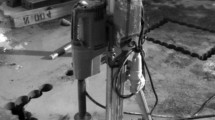When ground-penetrating radar inspection is used to determine the parameters of wood and concrete structural elements employed in commercial construction, both the radar scanning process and subsequent reduction of the data obtained should be automated. An automated antenna positioner was developed for ground-penetrating radar inspection of structural elements. A laboratory mockup of this automated antenna positioner was developed and examined to determine its performance. We demonstrate that such a positioner can be used for automated radar scanning and identification of high- and low-density zones in wood structures. We also show that the automated antenna positioner can be used to measure the electrophysical parameters of the host environment. An algorithm was developed to process the images of reinforced-concrete slabs, improve radar contrast, and detect metallic inclusions. Wiener filtration is found to be effective for noise suppression for reconstruction of rebar from radar images of reinforced-concrete slabs. Ground-penetrating-radar techniques can be used to verify component integrity and identify high-and low-density zones in structural elements.


Similar content being viewed by others
References
P. N. Aleksandrov, Theoretical Basis of Ground-Penetrating Radar, FIZMATLIT, Moscow (2017).
A. V. Andriyanov et al., Ground-Penetrating Radar, Radiotekhnika, Moscow (2005).
E. L. Shoshin, S. P. Luk’yanov, and D. M. Kovalev, Ground-Penetrating Radar in Engineering Surveys, Poligrafist, Khanty-Mansiisk (2008).
P. Annan, S. A. Arcone, et al., Ground Penetrating Radar: Theory and Applications, H. M. Jol (ed.), Elsevier Science, Kidlington (2009).
K. Harpreet and S. A. Neelofar, “A study for applications of histogram in image enhancement,” Int. J. Eng. Sci., 6, No. 6, 59–63 (2017).
V. M. Bortnikov and M. V. Abramchuk, “Development of a software component for an extended-object survey module in a lumber scanner,” Izv. VUZov. Priborostr., 61, No. 2, 167–173 (2018), DOI: 10.17586/0021-3454-2018-61-2- 167-173.
J. Janicka and J. Rapiński, “Filtering the results of ZIGBEE distance measurements with RANSAC algorithm,” Acta Geodyn. Geomater., 13, No. 1 (181), 83–88 (2016), DOI: 10.13168/AGG.2015.0043.
A. Gonzales and R. Woods, Digital Image Processing [Russian translation], Tekhnosfera, Moscow (2005).
W. K. Pratt, Digital Image Processing [Russian translation], Mir, Moscow (1982), Vol. 2.
E. L. Shoshin, State Comp. Software Registr. Certif. No. 2013660323, “Software for calculating the parameters of rebar in concrete slabs,” reg. Oct. 30, 2013, Reestr Progr. EVM.
Author information
Authors and Affiliations
Corresponding author
Additional information
Translated from Izmeritel’naya Tekhnika, No. 10, pp. 47–51, 2019.
Rights and permissions
About this article
Cite this article
Shoshin, E.L. Ground-Penetrating Radar Inspection to Determine the Characteristics of Commercial Wood and Concrete Structures. Meas Tech 62, 900–904 (2020). https://doi.org/10.1007/s11018-020-01711-5
Received:
Accepted:
Published:
Issue Date:
DOI: https://doi.org/10.1007/s11018-020-01711-5




